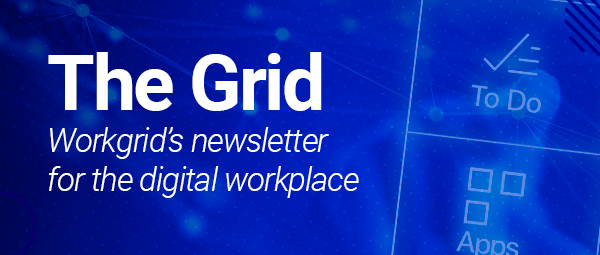What is an Enterprise Copilot?
An enterprise copilot utilizes conversational AI to provide support for employees across different channels, systems, and knowledge repositories within the enterprise tech stack. The term copilot itself implies how these AI Assistants support employees throughout their workday, guiding them to important information and tasks that require their attention.
The term copilot has become increasingly popular in recent years, particularly as a client-specific tool offered by large software companies. However, copilots come in various forms and sizes, all with the shared objective of enhancing the employee experience.
Digital Assistant Technology for the Enterprise
An enterprise AI copilot falls into the "digital assistant" category of workplace technology, but unlike the digital assistants of yesteryear copilots offer a smarter approach to the digital workplace. Historically, digital assistants were led by logic-based chatbot features, but AI-powered enterprise copilots deliver a more powerful solution by incorporating conversational features such as Retrieval Augmented Generation (RAG) and Natural Language Processing (NLP) that handle more complex queries.
More robust search and response capabilities are not the only ways enterprise copilots can improve the overall digital employee experience. A good copilot is not just reactive, but proactive as well. An AI Assistant should not only offer employee support when prompted, but also offer nudges and notifications based on employee attributes - from office location and job function to system-based tasks like expense approvals and upcoming training.
Why does it matter? The answer is simple. Copilots offer a look at tasks, apps, and information all within a single pane of glass. In an age where digital friction plagues the employee experience, copilots give employees a unified experience to find and access what they need through a conversational interface within the flow of work.
For digital workplace leaders, an enterprise copilot offers several benefits in maximizing AI technology to enhance the employee experience. These benefits include:
Improved knowledge discovery
Streamlined tasks
Reduced context switching
Guided attention
Let's explore each of these further.
Improved Knowledge Discovery
Conversational AI helps employees with knowledge discovery by providing a centralized source of information. It leverages advanced technology to consolidate, search, and surface responses based on natural-language cues. One such technology is Retrieval Augmented Generation (RAG), which takes a prompt and augments it with contextual data. This augmented prompt is then sent to a Large Language Model (LLM) that generates the most appropriate and up-to-date answers to employee questions. AI Assistants can efficiently collect and analyze information from various sources, including system APIs, knowledge repositories, and documents. This enables them to provide faster and more accurate answers to employees.
Streamlined Tasks
Copilots offer a broad range of use cases that streamline processes for performing tasks, from submitting time sheets to completing expense approvals. In many cases, copilots can also be leveraged for generative AI, giving employees the ability to generate content and gather insights within a controlled and safe AI environment.
A copilot enhances the employee experience by offering easy access to information and speeding up ticket resolution through self-service options. With the help of conversational AI, employees can conveniently access policies, frequently asked questions, and submit service tickets. They can also add comments, close tickets, or check for status updates. By connecting and searching through different resources like documents and systems, employees receive immediate support, resulting in reduced ticket handling time and allowing resources to be used more effectively for the organization's benefit.
Reduce Context Switching
Regularly switching between tabs and apps can be a major obstacle to employee productivity and can lead to frustration. Additionally, many organizations exacerbate this issue by introducing more technology, which only adds to the digital friction or what Gartner refers to as YATTC (yet another thing to check). However, an AI copilot can help alleviate this problem by consolidating apps, notifications, tasks, and information into a single interface. This unified experience allows employees to efficiently accomplish their tasks without the need for constant context switching.
Guided Attention
Increase efficiency by integrating business applications into an enterprise copilot. An intelligent AI Assistant supports employees by centralizing tasks and notifications that are typically spread across multiple systems. This integration creates a unified conversational interface, which proactively guides employees to areas that require immediate attention such as approvals, system alerts, and corporate communications.
![[asset] AI Work Assistant Information Apps](https://images.ctfassets.net/z7p73u8c0thn/6iNwr4tln1KhyJuNh73qX4/0b393f06fc943f0143b5b1c9412ac870/ai-work-assistant-information-apps-2x.png?w=1200&h=1078&q=60&fm=png&bg=transparent)
How to Find the Best AI Copilot for Your Organization
1. Ease of Deployment & Scalability
The ideal enterprise copilot should not only meet your current needs but also be capable of scaling and evolving alongside your company. As you begin to map out the various use cases which will build the foundation for creating a new employee experience, it's wise to ensure that your use cases can be implemented with little to no configuration.
A handful of vendors (including Workgrid Software) provide low/no-code platforms as a part of their general offering. In the case of Workgrid, we provide IT and business leaders with the ability to stand up over 50 use cases out of the box via our app templates. This allows the AI Work Assistant to readily meet integration needs based on the enterprise tech stack. The platform must be able to adapt to eventual shifting business requirements and/or technology replacements. Look for solutions that offer flexibility in terms of deployment, customization, and scalability to future-proof your investment.
2. Security & Data Management
In today's data-driven world, security is paramount. There are AI Assistants which have little to no control over what utterances may be passed over to feed a third-party LLM. Thus, look for a copilot that adheres to your stringent security and privacy standards. It’s important that whatever conversational AI Work Assistant is chosen, your choice complies with relevant regulations and industry standards. Moreover, both you and the vendor understand the potential sensitive or proprietary information that may be passed back and forth from system to system – better still, you are able to bring your own LLM to further protect your data.
3. Ubiquitous Channel Offerings
Find a copilot that offers a universal solution across your organization. An AI Assistant should be an ubiquitous solution that connects across systems, applications, and services, agnostic of a specific department or job role. These types of assistants should be customizable, with the ability to tailor experiences to employee personas and work styles as well as reach across all back-end applications and even multiple AI services. This means less app hopping for the employee and a single platform for developers.
Bringing an AI Copilot to your Digital Workplace
As workplaces embark on a future enriched with AI-forward technology, it is imperative that the systems and processes leaders invest in are secure, scalable, and add value across the existing applications employees use every day. Taking the first step with an enterprise AI copilot empowers employees with solutions that help not only their productivity, but overall employee experience.




